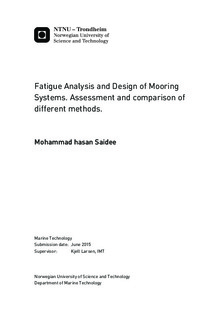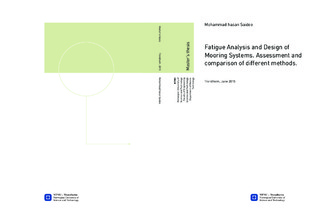| dc.contributor.advisor | Larsen, Kjell | |
| dc.contributor.author | Saidee, Mohammad hasan | |
| dc.date.accessioned | 2015-10-05T15:03:55Z | |
| dc.date.available | 2015-10-05T15:03:55Z | |
| dc.date.created | 2015-06-09 | |
| dc.date.issued | 2015 | |
| dc.identifier | ntnudaim:13557 | |
| dc.identifier.uri | http://hdl.handle.net/11250/2350726 | |
| dc.description.abstract | This master thesis deals with several problems in connection with the evaluation of fatigue damage for mooring lines. One basic problem is to find out the sea states contributing most to the fatigue loads characterized by the waves height (H_s) and the spectral peak period (T_p). This problem is investigated by designing an intact mooring system and carrying out long term simulations both in frequency domain (FD) and time domain (TD). It is found that sea states with wave heights from 6m to 10m and peak periods from 10s to 16s give higher fatigue damage.
In addition to this, comparative studies of different methods that are available to calculate mooring lines fatigue damage have been carried out both in time domain and frequency domain. It will help the mooring systems designers to decide which method to apply for a particular case. It is found that rain flow counting method based on TD analysis gives much higher fatigue damage comparing to others based on FD analysis. Simple summation approach underestimates the damage and combined narrow band approach overestimates the damage in contrast with dual narrow-band approach which is assumed to give relatively accurate result.
In this thesis especially the fatigue damage of the mooring system of ship-shaped FPSO units are assed. For all direction of environmental loading it is observed that leeward lines experience higher fatigue than windward line. It is a special phenomenon of ship-shaped FPSO which is caused due to elliptically looped wave frequency motion of the vessel.
A simplified method is proposed here to estimate fatigue damage by using information from the ULS design results. The intension is to find a simplified way to check whether the mooring systems satisfy fatigue limit state (FLS) design criteria, especially for MODUs which are usually not designed against fatigue. It will also give an idea whether a detail fatigue analysis is needed or not.
Apart from this, relevant literature and existing mooring and station keeping systems have been reviewed. | |
| dc.language | eng | |
| dc.publisher | NTNU | |
| dc.subject | Marine Technology, Marine Structures | |
| dc.title | Fatigue Analysis and Design of Mooring Systems. Assessment and comparison of different methods. | |
| dc.type | Master thesis | |
| dc.source.pagenumber | 103 | |

